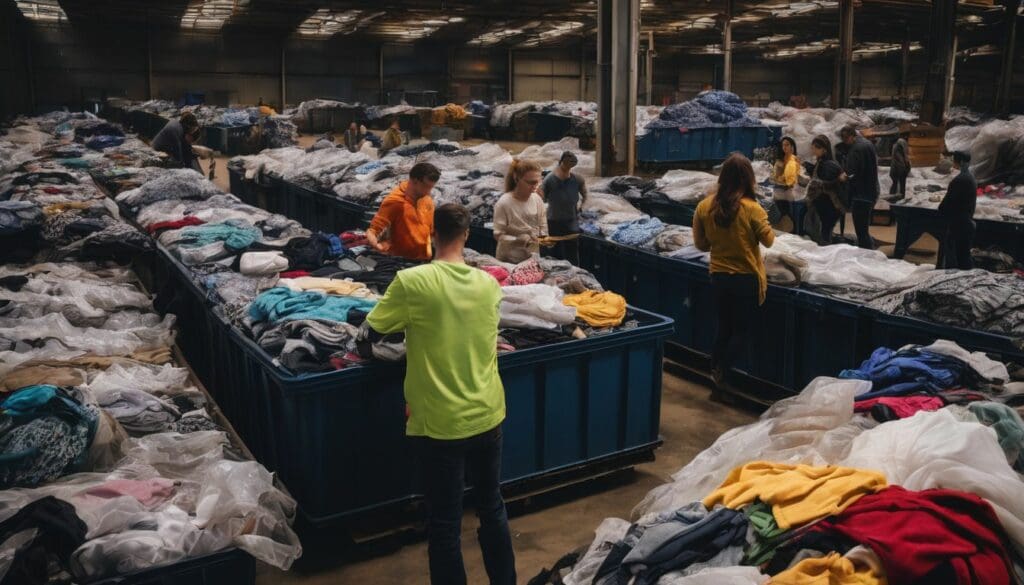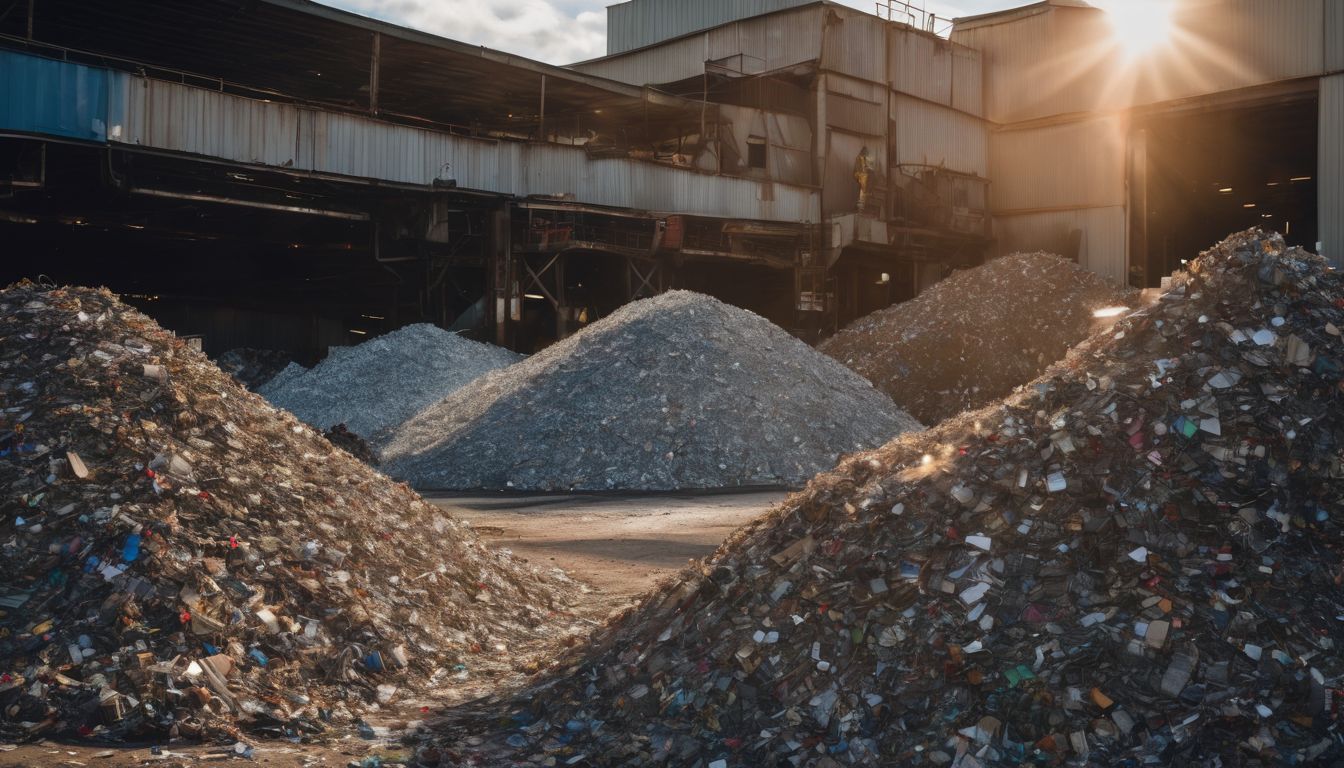Many of us wonder where our donated clothes really end up. Every year, tonnes of textiles are saved from landfills through charitable acts of recycling. This blog will unravel the journey of your donated garments and reveal how they can make a positive environmental impact.
Prepare to be enlightened!
Key Takeaways
- Donating clothes to local charities or using store take – back programs helps keep textiles out of landfills and supports community projects.
- Old garments can be repurposed into new products like rags or filler for furniture at textile recycling centers, promoting sustainable practices.
- The fashion industry’s move towards fast fashion increases the rate of consumption and disposal, leading to more textile waste that affects both the environment and society.
- Unsold donated clothing may be exported overseas where it can impact local economies and contribute to environmental issues in those regions.
- Making a difference involves reducing how much we buy, reusing old clothes creatively, choosing sustainable brands, and donating responsibly.
The Journey of Your Donated Clothes
Your donated clothes may go through various channels, including local charities, roadside donation bins, store take-back programs, or even the garbage. Each option has different implications for the environment and those in need.
Donating to a local charity
Giving your old clothes to a local charity can spark new life into your garments. Charitable organisations often have shops where they sell secondhand clothing. The proceeds help support their community projects and initiatives.
This means that the jumper you no longer wear could contribute to someone’s meal, shelter, or education.
Before you donate, check with the charity about what items they need most. Ensure that the clothes are clean and in good condition so they can be sold or given directly to those in need.
Dropping off donations at a designated spot helps textile recycling efforts and reduces environmental waste by keeping fabric out of landfills. Every shirt, skirt, or pair of trousers donated is one step closer to sustainable fashion practices and supporting eco-friendly textiles within our communities.
Dropping off at a roadside donation bin
After considering donating to a local charity, another option is dropping off at a roadside donation bin. This convenient method allows you to contribute by depositing your unwanted clothes into designated bins placed in accessible locations within your community.
Many of these roadside donation bins are affiliated with charitable organisations or textile recycling centres that efficiently process the donated clothing for reuse or recycling.
When using a roadside donation bin, ensure that you donate clean and wearable clothing items to maximise their potential for reuse or recycling. By utilising this easy and accessible method of donating clothes, you are actively participating in diverting textiles from landfills while contributing towards sustainable fashion and environmental conservation efforts.
Using a store’s take-back program
Take advantage of your favourite clothing stores’ take-back programmes. When you bring in your old clothes, the store ensures they are responsibly recycled or repurposed. This reduces textile waste and encourages sustainable fashion practices.
Many stores offer incentives for participating, such as discounts on new purchases or loyalty points. By using these take-back programmes, you directly contribute to reducing environmental impact while supporting responsible textile disposal.
Remember that when you use a store’s take-back programme, you actively promote eco-friendly practices within the fashion industry and help minimise the negative consequences of textile waste on our planet.
Discarding in the garbage
When discarded in the dustbin, old clothes contribute to the growing problem of textile waste. Each year, a staggering amount of textiles end up in landfills, where they decompose and release greenhouse gases while taking up valuable space.
This disposal method not only harms the environment but also wastes resources that could be reclaimed through recycling.
Transitioning from discarding clothes to responsible donation or recycling is crucial for reducing textile waste and its impact on the planet. Let’s explore how clothing donations can make a positive difference in minimising environmental harm and supporting sustainable practices.
The Reality of Textile Waste
Textile waste has a significant environmental impact, with fast fashion contributing to the problem. Find out how you can make a difference and learn more about textile recycling in our blog.
The environmental impact
The environmental impact of textile waste is significant, with the fashion industry being one of the largest polluters globally. The disposal of used clothing contributes to overflowing landfills and releases harmful gases into the atmosphere during decomposition.
Additionally, the production and transportation of new clothes lead to high levels of carbon emissions, further exacerbating climate change. This cycle perpetuates environmental degradation and resource depletion on a massive scale.
To combat this issue, it’s essential for individuals to support sustainable practices such as donating old clothes to responsible organisations, reusing textiles in creative ways or supporting sustainable fashion brands.
By making conscious decisions about clothing disposal and consumption, we can collectively reduce the environmental impact while promoting a more eco-friendly approach to textile usage.
The role of fast fashion
Fast fashion plays a significant role in the textile waste crisis, with its focus on producing inexpensive clothing quickly. This often leads to lower quality garments that are designed for short-term use, contributing to a disposable consumer culture and increasing clothing turnover.
The pressure to keep up with rapidly changing trends fuels overconsumption, resulting in vast amounts of discarded clothing annually.
Mass production and low-cost manufacturing processes also lead to environmental harm through excessive water usage, chemical pollution, and increased carbon emissions during transportation.
Textile Recycling: What Happens to Your Donated Clothes
Donated clothes are processed at textile recycling centers, where they may be cut into rags or repurposed as filler for furniture. To learn more about the journey of your donated clothes and how you can make a difference, keep reading!
Processing at textile recycling centers
Textile recycling centers process donated clothes in several ways:
- Sorting: Donated clothing is sorted by type, fabric, and condition.
- Cleaning: The clothes are thoroughly cleaned to remove any dirt or contaminants.
- Shredding: The textiles are then shredded into fibers or small pieces for ease of handling.
- Reprocessing: These fibers are then reprocessed into new yarns or fabrics.
- Upcycling: Some textiles may be upcycled into new products like insulation or carpet padding.
- Resale: Wearable items may be sold as secondhand clothing.
Cutting into rags
After the donated clothes are collected and processed at textile recycling centers, they are cut into rags. This process involves sorting the textiles by type and colour before cutting them into smaller pieces for various applications.
The resulting rags can be used in a wide range of industries, including automotive, construction, and manufacturing. By repurposing old clothing into rags, it reduces the demand for new resources while providing a sustainable solution for textile waste.
The use of recycled rags also supports eco-friendly practices by reducing the amount of waste sent to landfills. Additionally, this process contributes to conservation efforts by extending the lifespan of textiles and promoting a circular economy within the fashion industry.
Repurposing as filler for furniture
Textile waste mills process donated clothing by repurposing it as filler for furniture, reducing the need for new materials and contributing to a more sustainable approach. This practice helps to extend the lifespan of textiles and minimises environmental impact while also providing an eco-friendly alternative for manufacturing furniture.
The development of innovative methods in textile reprocessing contributes to the reduction of waste, creating opportunities for individuals dedicated to supporting conservation efforts.
Textiles repurposed into filler material can offer environmentally conscious consumers an ethical choice when furnishing their homes without compromising on quality or style.
Overseas Exports
Unsold clothing may end up being exported to other countries, impacting local economies and environments. It’s important to consider the global effects of textile waste and how we can make a positive impact.
Where unsold clothing may end up
Unsold clothing may end up being sold to developing countries in bulk. These clothes often flood local markets, impacting the sales of locally made garments. The excess creates a dependency on importing secondhand clothing, causing economic strain on local textile industries.
Some communities in these countries welcome the influx of affordable clothing; however, it can hinder their own economic development and sustainability. The surplus also leads to environmental concerns as discarded textiles contribute to waste management challenges for these societies where recycling infrastructure is limited.
The impact on local communities
Local communities can benefit from your textile recycling efforts. When you donate your clothes to local charities or participate in take-back programmes, you support the job market by creating opportunities for workers in textile waste recycling centres and secondhand clothing shops.
By doing so, you help reduce the environmental impact of fast fashion on local ecosystems, promoting eco-friendly textiles that are repurposed or upcycled.
Unsold clothing can be redirected to help those in need within local communities through charitable donations. This not only reduces textile waste but also supports sustainable fashion choices and encourages responsible organisations focused on clothing reclamation and reuse.
By making a difference at a local level, you contribute to positive change within your community while supporting environmental conservation efforts.
How to Make a Difference
Reduce your clothing consumption, repurpose and reuse old clothes, donate to responsible organisations, and support sustainable fashion brands to make a positive impact on textile waste.
Reducing consumption
To lower the environmental impact of textile waste, it is essential to reduce clothing consumption. By purchasing fewer items and choosing quality over quantity, you can help decrease the demand for fast fashion and lessen the amount of clothing that ends up in landfills.
Supporting sustainable fashion brands and investing in timeless pieces made from eco-friendly textiles are also effective ways to minimise consumption.
Another way to make a difference is by embracing a minimalist lifestyle. Emphasising on versatility rather than constantly buying new clothes will not only benefit the environment but also encourage mindful consumption habits.
Adopting a “buy less, choose well, make it last” approach supports conservation efforts and promotes responsible textile disposal practices.
Reusing and repurposing clothing
Transitioning from reducing consumption, another impactful way to support sustainable fashion is by reusing and repurposing clothing. Instead of discarding old clothes, consider upcycling them into new items, such as turning t-shirts into tote bags or using fabric scraps for crafting projects.
By giving your clothing a second life, you not only reduce textile waste but also minimise the demand for new materials and production. Look for creative ways to extend the lifespan of your garments, whether it’s through DIY alterations or supporting businesses that specialise in repurposing textiles.
Instead of throwing away worn-out pieces, consider donating them to organisations that can transform them into something new or utilise them as filler material for furniture and insulation.
Donating to responsible organizations
Transitioning from the concept of reusing and repurposing clothing, donating to responsible organisations can further support sustainable fashion initiatives. Ensuring that your secondhand donations reach reputable charities and textile recycling centres is crucial in reducing textile waste and promoting a circular economy.
By researching and choosing ethical organisations that prioritise environmentally friendly practices, you contribute to the conservation efforts while supporting communities in need.
Sustainable clothing disposal involves actively seeking out charitable textile donation centres or eco-friendly fabric repurposing facilities. Donating clothes to charity ensures that your used clothing disposal positively impacts both the environment and society, aligning with your commitment to environmental conservation.
Supporting sustainable fashion.
Support sustainable fashion by choosing clothing made from eco-friendly textiles and participating in upcycling clothes initiatives. Encourage responsible wardrobe disposal by donating to reclamation centres or secondhand clothing donation programmes.
Drive change through reducing consumption, reusing and repurposing clothing, and supporting organisations that promote sustainable fashion.
By embracing sustainable fashion choices such as upcycling clothes and recycling textiles, you actively contribute to environmentally friendly practices while supporting conservation efforts.
Conclusion
In summary, your donated clothes go through a journey after you drop them off. They can be recycled into rags or repurposed as filler for furniture at textile recycling centers. It’s important to consider the impact of textile waste on the environment and local communities.
Making a difference includes reducing consumption, reusing clothing, and supporting sustainable fashion initiatives. Take action now to contribute towards a more sustainable future for our planet!
FAQs
1. What is textile recycling and how does it work?
Textile recycling takes your donated clothes to clothing reclamation centers where they are sorted, cleaned, and processed into ecofriendly textiles or other products.
2. Can all donated clothes be recycled at these facilities?
Not every item can be recycled, but many clothing donation processes ensure that what can’t be reused gets converted responsibly by textile waste mills into new materials.
3. Is donating clothes a sustainable way to dispose of unwanted items?
Yes, donating clothes is a form of sustainable clothing disposal because it extends the life of garments and reduces landfill waste.
4. What should I do before donating my clothes for recycling?
Make sure your clothes are clean and in good condition; this helps streamline the recycling process at clothing reclamation centers and increases their chances of being reused or recycled.





